Planned giving marketing: How to create messaging that works

Planned gifts, also called legacy gifts, are often the largest and most transformational gifts your nonprofit will ever receive. But asking for them can feel awkward or complex.
It doesn't have to be!
The secret is a donor-centric planned giving marketing strategy. This approach focuses on your donors’ values and their desire to create a lasting legacy, not just on your organization’s needs.
This guide is your complete playbook. We’ll cover the essential materials you need, the right words to use, and the engagement strategies that will help you master marketing planned giving and secure your nonprofit's future.
Planned giving marketing FAQ
Marketing your planned giving program can feel like a big undertaking, but the core concepts are straightforward. To get you oriented, we’ll answer common questions you might have before diving into specific strategies and materials.
Why should you promote your planned giving program?
For any fundraising effort to be successful, donors need to know about it! Your donors might be unfamiliar with the various forms of planned giving or have misconceptions about what it means or how the process works. Educating and informing your donors about their giving options should be a key goal of your marketing efforts.
Who should you target with your planned giving marketing?
You should promote planned giving to all of your donors in one way or another. Planned giving gives every donor the opportunity to have an outsized impact on your mission because their gift won’t affect their income and day-to-day finances. Appeal to specific segments of your audience with more tailored messaging and launch new promotional campaigns over time.
What are the key elements of a planned giving marketing strategy?
An effective planned giving marketing strategy functions as a complete system. It combines foundational assets, consistent messaging, and active donor engagement to build trust and secure gifts.
Be sure to include these elements:
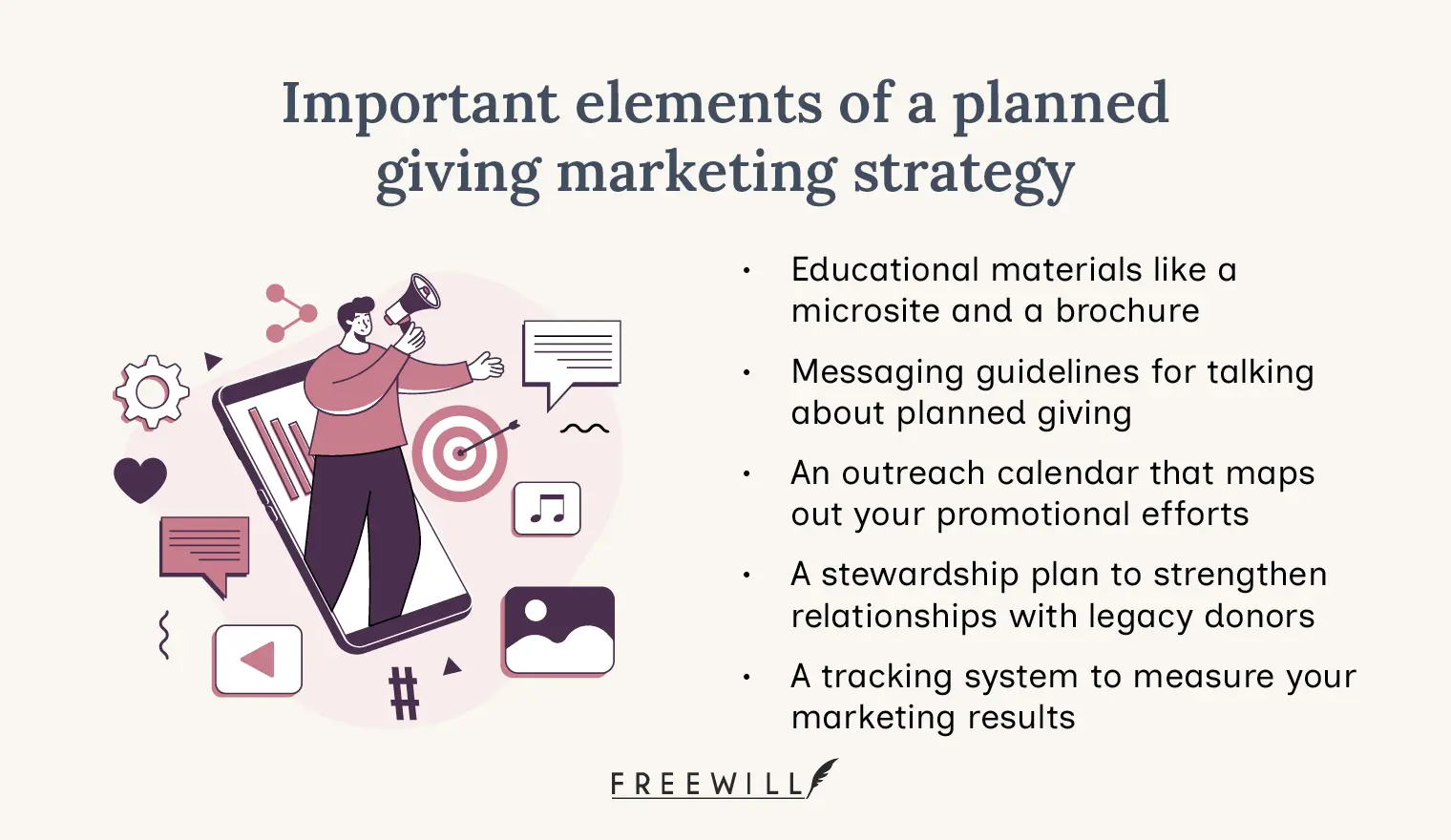
- Educational materials: A dedicated website page or microsite and a compelling planned giving brochure to establish credibility and educate donors
- A messaging guide: A clear set of phrases, email templates, and guidelines on how to talk about planned giving empathetically and effectively
- A consistent outreach calendar: A plan that maps out your promotional campaigns, such as dedicated emails and integrated mentions in your general newsletter
- A stewardship plan: A legacy society to build community and recognize donors, as well as exclusive events for top prospects
- A tracking system: A structure to measure your results over time, allowing you to see what works and improve your strategies.
These elements all work together to create a seamless, donor-centric journey. By having these pieces in place, you make it easy to inspire a supporter to take the next step, from casual interest to a committed legacy gift.
Foundational planned giving marketing materials
A proactive planned giving marketing strategy starts with having the right information ready before a donor asks. These foundational materials serve as a reference point, making complex giving options easy to understand.
So, what marketing materials will you need to effectively promote planned giving, and how should you use them? Take a look at these best practices:
1. Create a planned giving page or microsite.
Your goal should be to make it easy and intuitive for your supporters to learn about planned gifts and make one to your organization.
One of the best ways to achieve this is by creating a dedicated landing page or microsite that defines the main types of planned gifts and how to make them. Alternatively, you can add a section to your main “Ways to Give” page that lets supporters request more information about your planned giving program.
Information to include on your planned giving page
Think of your microsite or landing page as your digital planned giving marketing brochure. It provides all the information a prospective donor needs to understand their legacy giving options, the benefits of making a commitment, and how to get started.
Your program’s page or microsite should include:
- Planned giving options: Clearly define each planned giving option by explaining what the gift means for the donor. For instance, if your donor is leaving a bequest, it’s fairly straightforward, as the donor simply allocates a portion of their estate to a nonprofit in their legal will. However, other types of planned gifts, such as charitable gift annuities, are more complicated and need further explanation. Just avoid bogging down your explanations with too much jargon.
- Contact information for the person in charge of planned giving: Your page may not provide all the details your prospects need, or donors may have additional questions. Provide contact information so they can call or email the person in charge of planned gifts at your organization.
- Information about your legacy society: A legacy society is a membership association for people who have made a planned gift to your organization. We’ll go into more detail about these later in this article, but they can be a great resource and community for your planned giving donors. On your page, outline the perks and benefits of being a member.
- A clear call to action: Your page should include a button that links to a form where prospects can request more information or even make their will. Place it in a prominent location and use language that describes the action you want donors to complete. For example, you can say, “Create your legacy!” or “Start your will!”
An example of a planned giving microsite
For inspiration, check out The American Red Cross. They dedicated a whole site to planned giving, redcrosslegacy.org. Then, they linked to it on their main “Ways to Give” page to increase visibility.
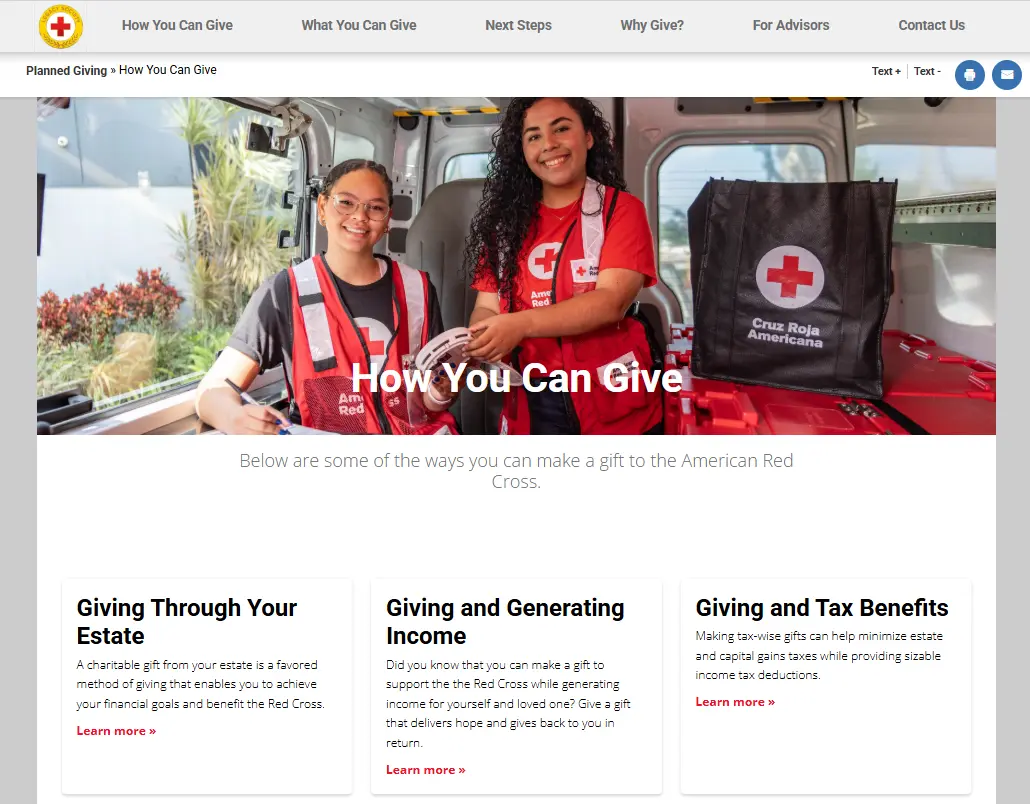
When you explore the site, you’ll notice they include detailed landing pages for specific types of gifts, recommended planned gift messaging, the benefits of legacy giving, and tools to get started. Check out the information on their page about bequests:
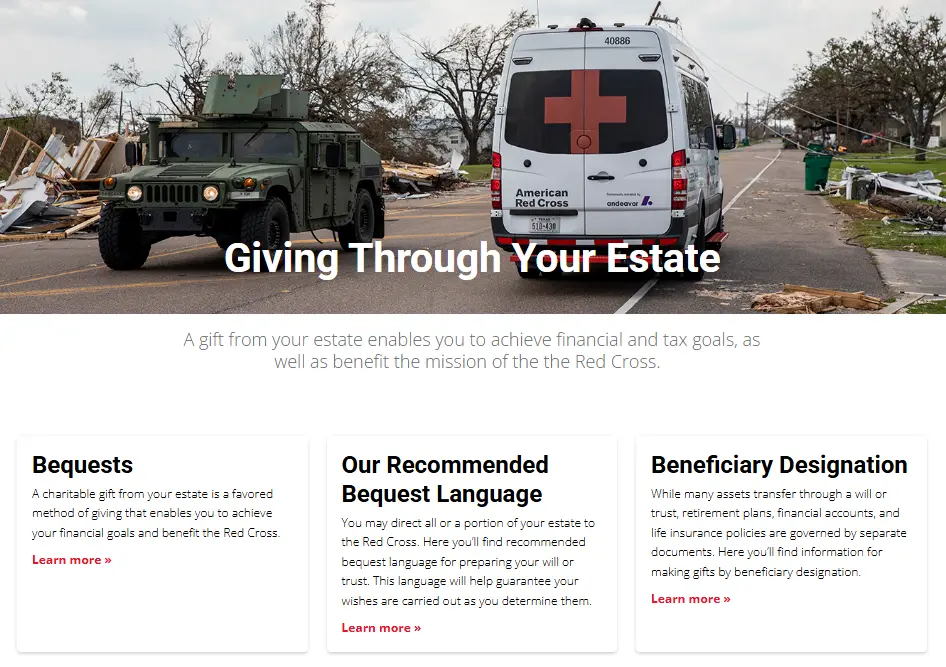
The easiest way to launch a planned giving microsite
To simplify the process of marketing your planned giving program online, turn to FreeWill’s Planned Giving Microsites. We equip your nonprofit with everything you need to engage donors and educate your audience about planned gifts.
To see how easy it is to launch your microsite, explore our interactive demo:
Your site will help establish trust among donors, making them more comfortable with legacy giving through an easy-to-navigate interface. They’ll have everything they need to better understand their options and even get started with our planned giving tools.

2. Email planned giving information to your supporters multiple times a year.
Many of your supporters want to make a bigger impact, but may not know what planned giving is or how to make a gift to your organization. To be donor-centric, you should aim to make every donor aware of opportunities where they can make a bigger difference. By educating supporters about planned giving, you’re helping them decide which giving option best meets their philanthropic goals and needs.
As with all effective marketing, repetition is key for seeing results. A supporter may open an email about planned giving several times before actually sitting down to make a will and commit a bequest.
From our work with hundreds of nonprofits, we've found that the most effective marketing strategy includes two to three standalone promotional campaigns per year along with several integrated mentions in other communications. Standalone emails have a single call-to-action, like “create your legacy.” Integrated mentions list planned giving along with other giving options.
Your planned giving outreach can take many forms, from dedicated campaigns to mentions in your existing communications. The key is to give your donors multiple opportunities to learn.
Examples of planned giving marketing outreach include:
- A full campaign for National Make-A-Will Month in August
- Postscript mentions in general fundraising appeals
- Legacy donor stories (we’ll go into the power of donor stories below)
- Newsletter mentions
- Ways to donate on GivingTuesday
- Legacy society announcements
When sending outreach, we recommend prioritizing email over direct mail. Even older folks are more likely to respond that way. Don’t underestimate the power of standalone emails promoting planned giving either. We’ve found that they’re twice as successful at generating legacy gifts as emails with multiple options to give!
However, we know it can be tough to incorporate planned giving outreach into a packed communications calendar, especially with a smaller team. But you don’t have to write your emails from scratch, because we’ve created email templates with effective planned giving marketing language to save your nonprofit time.
3. Design a compelling planned giving brochure.
A planned giving brochure is a key, tangible piece of your marketing toolkit. It translates the complex world of legacy gifts into a simple, compelling, and professional-looking document.
While your website is your digital hub, a high-quality “one-pager” provides a physical touchpoint a donor can hold and review at their own pace. It’s a versatile tool that answers key questions and can be easily shared among donors who respond better to or prefer printed materials. Your team can bring its brochure to events or programming where interested donors will be present.
What to include in your brochure
A brochure must be inspiring at a glance. Unlike your microsite, which can host detailed information, your brochure should focus on the highlights. Here’s what you might include:
- Planned gift options: Spotlight the main types of gifts you accept, such as gifts in a will or gifts from a retirement plan. The goal isn't to explain how they work, but to simply show the different ways a donor can make an impact.
- Visuals and branding: Use high-quality photos related to your mission. All visuals, fonts, and colors should also align perfectly with your nonprofit's established brand identity to build immediate recognition.
- Donor-centric language: Use warm, empathetic language that focuses on the donor's impact and their power to “create a legacy.” A study by planned giving expert Dr. Russell James uncovered that framing legacy giving as a way to “support causes that have been important in your life” can increase donor interest from 12% to 40%, compared to “make a bequest gift to charity.”
- Financial benefits: You can briefly note that some planned gifts may offer financial benefits (like tax savings). This should be a secondary point, as the primary motivator should always be your mission.
- A mention of your legacy society: Introduce your legacy society as a special community for donors who have made a planned gift.
- A URL or QR code for your microsite: This is the perfect, low-pressure call to action. It gives interested donors a clear, digital path to learn more on their own time.
- Contact information: Provide a name, phone number, and email for a real person. This makes the next step feel personal and accessible, signaling a confidential, no-obligation conversation.
Messaging tips for talking about legacy giving
When it comes to discussing legacy giving, the right words are essential to building trust. A thoughtful approach will make your supporters feel valued and seen, not just solicited. Use the following tips to craft your messaging to ensure your planned giving marketing is empathetic, personal, and highly effective.
4. Be thoughtful and empathetic when writing about planned giving.
Planned giving can be a sensitive topic for supporters. To be donor-centric when communicating about planned gifts, emphasize that they allow supporters to make the biggest impact of their lives. Even though you won’t receive their gift until after they pass, donors can still fully decide how their gift will be used. And with their support, your organization can better plan for the future.
Additionally, remember these best practices when writing or speaking about legacy gifts:
- Don’t mention death. Legacy fundraising research shows that mentioning death decreases a person’s interest in making a legacy gift. That’s because reminders about death cause two reactions in people: avoidance or the pursuit of a lasting impact. Instead of talking about death, focus your communications on how your donors can create a legacy. Avoid language like “leave a legacy” because it implies death. Instead, use language such as “create a legacy” or “make a gift in your will.”
- Acknowledge that this form of giving may be new to your supporters. This can trigger curiosity in prospects instead of making them feel as though they “should have” known about this type of giving already. For example, try using: “Did you know?” or “You might be surprised to learn…” in your outreach.
- Highlight the range of ages making planned gifts. This will help your older donors feel less targeted and like part of a broader audience. For example, you can say: “Supporters of our humane society, from 18 to 88, choose to include us in their will or trust. Would you like information on how to join them?”
5. Personalize your marketing outreach to make supporters feel valued.
When speaking to your nonprofit, donors might feel like they’re talking to an entity rather than a human being. Personalizing your planned giving outreach makes them feel like they’re speaking to a real person who’s interested in their values and needs.
Here are some easy ways to personalize your outreach:
- Use “you” language instead of “I” language. For example, instead of “we need your support to help our nonprofit pursue its mission for generations to come,” you might say, “You can create a lasting impact on a cause that has been important in your life, and your legacy gift will support generations to come.” This simple shift in focus makes your outreach feel like a personal conversation, not a marketing blast.
- Use a donor’s first name in any written communications. Seeing or hearing your first name triggers brain activation in a place called your reticular activating system, or RAS. By using names in your outreach, donors will feel like the content was written specifically for them. Luckily, most email platforms allow you to customize emails with a contact’s first name when integrated with your CRM.
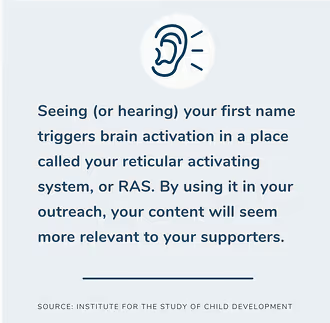
Ultimately, these simple touches show donors they’re valued partners in your mission, making them much more receptive to your planned giving marketing messages. By connecting with them on a personal level, you’ll build the essential trust required for a meaningful legacy conversation.
6. Use donor stories as social proof in your planned giving marketing.
Donor testimonials are a great marketing strategy that can help illustrate the tangible impact of a legacy gift. And they’re a powerful way to show that your organization values each donor.
Plus, donor stories are an effective form of positive social proof. Social proof is the idea that supporters want to act in ways that are similar to their peers, and it’s extremely effective — donors are 15% more likely to leave a bequest when they believe they’re “one of many supporters” doing the same. And gift size increases by almost $6,000.
On your Planned Giving Microsite, include several forms of social proof. Small testimonials, photos of your legacy society events, and longer donor spotlights can all help show prospective donors that planned giving is a popular option. Even simple language choices like "many of our supporters choose to establish planned gifts because..." will demonstrate that planned giving is an accessible and easy option.
To keep your stories donor-centric, focus on the impact of the gift and the background of the donor, rather than the size of the gift itself. Elon University created a Donor Stories page that features some inspiring examples of legacy donors. This example talks about how a legacy gift from an alumnus provided financial support to students at the school:

Donor engagement strategies to market planned giving
Effectively promoting your planned giving program is about actively deepening relationships with your most loyal prospects. Let’s explore legacy donor engagement strategies that move from broad outreach to high-touch engagement:
7. Create a legacy society to deepen relationships with planned giving donors.
A key part of a donor-centric planned giving marketing strategy is a legacy society, a membership association for people who have made a planned gift to your organization. It gives donors a lifelong sense of community and connection to your cause.
Your society members can spread the word about your nonprofit. And you can deepen your relationship with these donors by hosting exclusive events, recognizing them publicly, and inviting them to volunteer or advocate for your mission. This can also lead to more gifts or plant the seeds for larger gifts in the future.
This example from the Breast Cancer Research Foundation outlines the benefits of their legacy society, as well as the guidelines for eligibility. They’ve also named their society after their founder:

Once you’ve picked a society name and logo, you may want to send new members a welcome gift. This can be a pin or a letter from your CEO or board thanking them for their bequest.
8. Host exclusive events for your engaged legacy giving prospects.
Invite your most engaged prospects to small, exclusive events. Whether virtual or in-person, these high-touch gatherings help supporters feel a deeper connection to your team, your mission, and other loyal donors.
Keep the focus of your events on the donor's values and the impact their gift could have, not on your organization's needs. Here are a few event examples:
- Informational luncheons, where you can provide more details about planned gifts
- Tours of your facilities, where prospects can meet the team or executives
- Dinners or formal house parties hosted by one of your board members or executives
During these events, make donors feel like valued partners by introducing them to key leaders, like your board members or executives. Be sure to have copies of your planned giving brochure on hand for an easy, tangible follow-up for anyone who expresses interest.
These events are a "conversion" tactic, so they’re best reserved for prospects who are very close to making a planned gift—those who have been responsive to your outreach and just need a few more personal touchpoints.
Additional resources for your planned giving program
Ultimately, a planned giving marketing strategy is how you move from being a passive recipient of “someday” gifts to a proactive partner in your donors' legacies.
This guide has given you the playbook. Now, it’s up to you to get started and start securing the transformational, long-term funding your mission deserves. Remember, FreeWill’s Planned Giving Suite is designed to power your entire system and make planned giving more accessible for your donors. Start there, and legacy giving will become a solid revenue stream for your cause.
To learn more about managing and growing your planned giving program, keep exploring with these additional resources:
- Make-A-Will Month marketing: 3 tips to boost planned giving
- How to start a planned giving program: Step-by-step guide
- Nonprofit marketing 101: How to build a next-level strategy
- The benefits of planned giving for nonprofits and donors
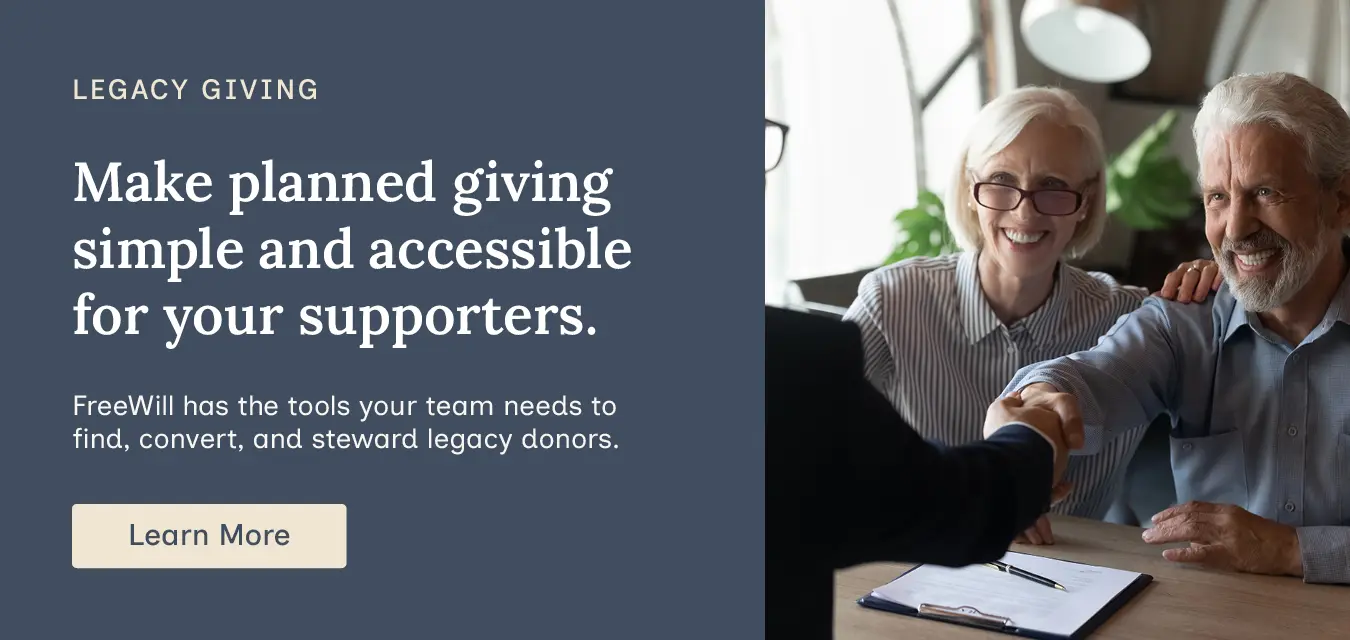
Join 10,000+ nonprofit professionals & learn the latest insights in fundraising
Join 10,000+ nonprofit professionals & learn the latest insights in fundraising





